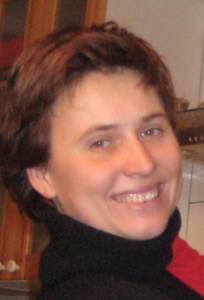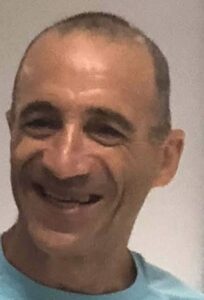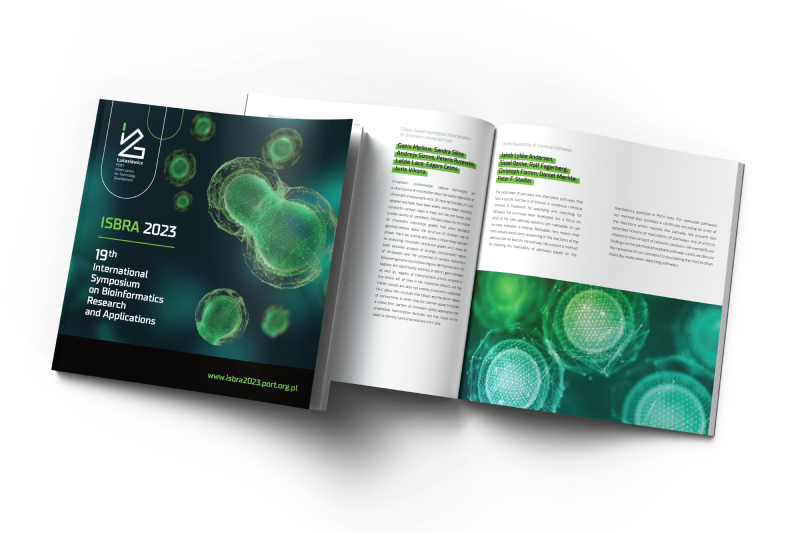Conference ISBRA 2023
The International Symposium on Bioinformatics Research and Applications (ISBRA) provides a forum for the exchange of ideas and results among researchers, developers, and practitioners working on all aspects of bioinformatics and computational biology and their applications. Submissions presenting original research are solicited in all areas of bioinformatics and computational biology, including the development of experimental or commercial systems. Topics of interest include but are not limited to:
- Biomarker discovery
- Biomedical databases and data integration
- Biomedical text mining and ortologies
- Biomolecular imaging
- Comparative genomics
- Computational genetic epidemiology
- Computational proteomics
- Data mining and visualization
- Gene expression analysis
- Structural biology
- Genome analysis
- Systems biology
The host of this year’s edition of Symposium on Bioinformatics Research and Applications (ISBRA) 9-12.10.2023 is Łukasiewicz – PORT Polish Center for Technology Development (Wrocław, Poland).
Conference regulations | download

Steering committee
Dan Gusfield UC Davis, USA
Ion MandoiuUConn, USA
Yi Pan (Chair) SIAT, China and GSU, USA
Marie-France Sagot INRIA, France
Zhirong Sun Tsinghua, China
Ying Xu UGA, USA
Aidong Zhang SUNY, USA
Zhipeng Cai GSU, USA
General Co-Chairs
Michal Malewicz PORT, Poland
Alexander Zelikovsky GSU, USA
Vice General Chair
Tianwei Yu The Chinese University of Hong Kong – Shenzhen
Program Co-Chairs
Xuan Guo UNT, USA
Murray Patterson UConn, USA
Serghei Mangul University of Southern California (USC), USA
Publicity Chairs
Olga Glebova GSU, USA
Local Arrangement Chair
Michal Malewicz PORT, Poland
Web Chair
Grigore Boldirev GSU, USA
Registration start: July 3, 2023
Registration end: October 12, 2023
Event start: October 9, 2023
Event end: October 12, 2023
The conference program you can find on the main website.
- Michael Souza, Nilton Maia and Carlile Lavor. The Ordered Covering Problem in Distance Geometry
- Gabriel Siqueira, Alexsandro Oliveira Alexandrino, Andre Rodrigues Oliveira, Géraldine Jean, Guillaume Fertin and Zanoni Dias. Approximating Rearrangement Distances with Replicas and Flexible Intergenic Regions
- Joyanta Basak, Ahmed Soliman, Nachiket Deo, Kenneth Haase, Anup Mathur, Krista Park, Rebecca Steorts, Daniel Weinberg, Sartaj Sahni and Sanguthevar Rajasekaran. On Computing the Jaro Similarity Between Two Strings
- Guy Katriel, Udi Mahanaymi, Christoph Koutschan, Doron Zeilberger, Mike Steel and Sagi Snir. Using Generating Functions to Prove Additivity of Gene-Neighborhood Based Phylogenetics
- Sumaira Zaman and Mukul S. Bansal. Reducing the impact of domain rearrangement on sequence alignment and phylogeny reconstruction
- Huixiu Xu, Xin Tong, Haitao Jiang, Lusheng Wang, Binhai Zhu and Daming Zhu. On Sorting by Flanked Transpositions
- Enrico Rossignolo and Matteo Comin. USTAR: Improved Compression of k-mer Sets with Counters Using De Bruijn Graphs
- Ming Chen, Bin Yao, Xiujuan Lei, Chunyan Ji, Zitao Hu and Yi Pan. Predicting Comprehensive Drug-Drug Interactions by Magnetic Signed Graph Neural Network
- Hui Feng, Guishen Wang and Chen Cao. BiRNN-DDI:A Drug-drug Interaction Event Type Prediction Model based on Bidirectional Recurrent Neural Network and Graph to Sequence Representation
- Md. Tofazzal Hossain, Md. Selim Reza, Yin Peng, Shengzhong Feng and Yanjie Wei. PCPI: Prediction of circRNA and protein interaction using machine learning method
- Wanyi Yang, Chuanfang Wu and Jinku Bao. PDFll: Intrinsic protein disorder and function prediction from the language of life
- Usama Sardar, Sarwan Ali, Muhammad Sohaib Ayub, Muhammad Shoaib, Khurram Bashir, Imdadullah Khan and Murray Patterson. Sequence-Based Nanobody-Antigen Binding Prediction
- Ahtisham Fazeel, Muhammad Nabeel Asim, Johan Trygg, Andreas Dengel and Sheraz Ahmed. Deep Learning Architectures For the Prediction of YY1-Mediated Chromatin Loops
- Boxin Guan, Anqi Wang, Yahan Li, Feng Li, Jin-Xing Liu and Junliang Shang. ABCAE: Artificial Bee Colony Algorithm with Adaptive Exploitation for Epistatic Interaction Detection
- Tian-Jing Qiao, Feng Li, Shasha Yuan, Ling-Yun Dai and Juan Wang. scGASI: A graph autoencoder-based single-cell integration clustering method
- Shuo Xu, Liping Kang, Xingyu Bi and Xiaohui Wu. Integrative analysis of gene expression and alternative polyadenylation from single-cell RNA-seq data
- Mathieu Bolteau, Jérémie Bourdon, Laurent David and Carito Guziolowski. Inferring Boolean networks from single-cell human embryo datasets
- Tai-Ge Wang, Xiang-Zhen Kong, Sheng-Jun Li and Juan Wang. CHLPCA: Correntropy-Based Hypergraph Regularized Sparse PCA for Single-cell Type Identification
- Zahra Tayebi, Akshay Juyal, Alex Zelikovsky and Murray Patterson. Simulating tumor evolution from scDNA-seq as an accumulation of both SNVs and CNAs
- Haijing Luan, Taiyuan Hu, Jifang Hu, Ruilin Li, Detao Ji, Jiayin He, Xiaohong Duan, Chunyan Yang, Yajun Gao, Fan Chen and Beifang Niu. Multi-Class Cancer Classification of Whole Slide Images through Transformer and Multiple Instance Learning
- Sarwan Ali, Usama Sardar, Imdadullah Khan and Murray Patterson. Efficient Sequence Embedding For SARS-CoV-2 Variants Classification
- Sarwan Ali, Pin-Yu Chen and Murray Patterson. Unveiling the Robustness of Machine Learning Models in Classifying COVID-19 Spike Sequences
- Yuxia Guan, Ying An, Fengyi Guo and Jianxin Wang. MPFNet: ECG Arrhythmias Classication Based on Multi-Perspective Feature Fusion
- Sarwan Ali, Haris Mansoor, Prakash Chourasia and Murray Patterson. Hist2Vec: Kernel-Based Embeddings for Biological Sequence Classification
- Yan Zhang, Xin Liu, Panrui Tang and Zuping Zhang. SGMDD: Subgraph Neural Network-Based Model for Analyzing Functional Connectivity Signatures of Major Depressive Disorder
- Hongyang Lei, Huazhen Huang, Bokai Yang, Guosheng Cui, Ruxin Wang, Dan Wu and Ye Li. TCSA: A Text-guided Cross-view Medical Semantic Alignment Framework for Adaptive Multi-view Visual Representation Learning
- Jordan Sturtz, Richard Annan, Binhai Zhu, Xiaowen Liu and Letu Qingge. A Convolutional Denoising Autoencoder for Protein Scaffold Filling
- Prakash Chourasia, Taslim Murad, Sarwan Ali and Murray Patterson. Enhancing t-SNE Performance for Biological Sequencing Data through Kernel Selection
- Sarwan Ali, Prakash Chourasia and Murray Patterson. PDB2Vec: Using 3D Structural Information For Improved Protein Analysis
- Ying An, Anxuan Xiong and Lin Guo. DCNN: Dual-Level Collaborative Neural Network for Imbalanced Heart Anomaly Detection
- Lusheng Wang and Zhaohui Zhan. Proteoform identification for top-down tandem mass spectra: efficient algorithms for global and local alignments with peak error correction
- Zhidong Yang, Hongjia Li, Dawei Zang, Renmin Han and Fa Zhang. SaID: Simulation-aware Image Denoising Pre-trained Model for Cryo-EM Micrographs
- Jovial Niyogisubizo, Zhao Keliang, Jintao Meng, Yi Pan, Didi Rosiyadi and Yanjie Wei. Attention-Guided Residual U-Net with SE Connection and ASPP for Watershed-based Cell Segmentation in Microscopy Images
- Ya Lv, Jin Liu, Pei Yang and Yi Pan. Multi-modality MRI Feature Interaction for Pseudoprogression Prediction of Glioblastoma
- Shaokai Wang, Ming Zhu and Bin Ma. NeoMS: Identification of Novel MHC-I Peptides with Tandem Mass Spectrometry
- Xiaodi Hou, Guoming Sang, Zhi Liu, Xiaobo Li and Yijia Zhang. Radiology Report Generation via Visual Recalibration and Context Gating-aware
- André Salgado, Francisco Fernandes and Ana Teresa Freitas. CSA-MEM: Enhancing Circular DNA Multiple Alignment through Text Indexing Algorithms
- Hafsa Farooq, Daniel Novikov, Akshay Juyal and Alex Zelikovsky. Genetic Algorithm with Evolutionary Jumps
- Carissa Bleker, Stephen Grady and Michael A. Langston. A Brief Study of Gene Co-Expression Thresholding Algorithms
- Hossein Saghaian, Pavel Skums, Yurij Ionov and Alex Zelikovsky. Graph-Based Motif Discovery in Mimotope Profiles of Serum Antibody Repertoire
- Huidong Ma, Cheng Zhong, Hui Sun and Haixiang Lin. ricME: long-read based mobile element variant detection using sequence realignment and identity calculation
- Casper Asbjørn Eriksen, Jakob Lykke Andersen, Rolf Fagerberg and Daniel Merkle. Reconciling Inconsistent Molecular Structures from Biochemical Databases
- Gatis Melkus, Sandra Siliņa, Andrejs Sizovs, Peteris Rucevskis, Lelde Lace, Edgars Celms and Juris Viksna. Clique-based topological characterization of chromatin interaction hubs
- Jakob Lykke Andersen, Sissel Banke, Rolf Fagerberg, Christoph Flamm, Daniel Merkle and Peter F. Stadler. On the Realisability of Chemical Pathways
- Rui Gao, Zixue Liu, Mei Meng and Jian He. Neurogenesis-associated Protein, a Potential Prognostic Biomarker in anti-PD-1 based kidney renal clear cell carcinoma patients’ therapeutics
- Bikram Sahoo and Alex Zelikovsky. Deep Learning Reveals Biological Basis of Racial Disparities in Quadruple-Negative Breast Cancer
- Bikram Sahoo and Alex Zelikovsky. Exploring Racial Disparities in Triple-Negative Breast Cancer: Insights from Feature Selection Algorithms
- Yulong Li, Hongming Zhu, Xiaowen Wang and Qin Liu. HetBiSyn: Predicting Anticancer Synergistic Drug Combinations Featuring Bi-perspective Drug Embedding with Heterogeneous Data
- Jingjing Zhang, Md. Tofazzal Hossain, Zhen Ju, Wenhui Xi and Yanjie Wei. Identification and functional annotation of circRNAs in neuroblastoma based on bioinformatics
- Xuehua Bi, Chunyang Jiang, Cheng Yan, Kai Zhao, Linlin Zhang and Jianxin Wang. Identifying miRNA-disease Associations based on Simple Graph Convolution with DropMessage and Jumping Knowledge
- Sarah von Loehneysen, Thomas Spicher, Yuliia Varenyk, Hua-Ting Yao, Ronny Lorenz, Ivo Hofacker and Peter F. Stadler. Phylogenetic Information as Soft Constraints in RNA Secondary Structure Prediction
- Rafał Stępień, Joanna Szyda, Bartosz Czech and Magda Mielczarek. The effect of transcriptomic annotations in breast cancer DGE study

Teresa Przytycka
Senior Investigator
Algorithmic Methods in Computational and Systems Biology (AlgoCSB)
NLM/NCBI
Teresa Przytycka is a Senior Investigator and the Chief of the Computational Biology Branch at the National Center for Biotechnology Information (NCBI), which is part of the National Institutes of Health (NIH) in the United States. The research in her group focuses on developing computational methods for systems biology including application to cancer research and gene regulation and methods for analysis of new types of experimental data.
She has worked on various topics, including protein structure prediction, functional annotation of genes, network biology, and cancer genomics. Throughout her career, Teresa Przytycka has published numerous scientific articles in reputable journals and has been actively involved in the bioinformatics research community. She has also served on program committees and advisory boards for several conferences and organizations related to bioinformatics and computational biology.

Anna Gambin
Faculty of Mathematics, Informatics and Mechanics
University of Warsaw
Anna Gambin is a professor at the Faculty of Mathematics, Informatics and Mechanics at the University of Warsaw. Her research interests include computational molecular biology and medicine: bioinformatics for genome rearrangements, algorithms for mass spectra processing, mathematical modelling of signaling pathways, comparative genomics of transposable elements.

Mark Robinson
University of Zurich
Switzerland
Mark Robinson has been an Associate Professor since 2017 after joining the Department of Molecular Life Sciences of the University of Zurich (UZH) in 2011. He studied Applied Mathematics (BSc, Uni. Guelph) and Statistics (MSc, Uni. British Columbia), and did a PhD in statistical bioinformatics at the University of Melbourne.
He has predoctoral experience at the Banting and Best Department of Medical Research (Uni Toronto) and postdoctoral experience in Cancer Epigenomics at the Garvan Institute in Sydney. The Robinson group at UZH develops statistical methods for interpreting high-throughput sequencing and other genomics technologies in the context of genome sequencing, gene expression and regulation and analysis of epigenomes, with a current focus on the analysis of single-cell and spatial datasets.

Sagi Snir
University of Haifa
Israel
Sagi Snir is a professor of computational evolution at the University of Haifa in Israel, where he has established and headed the Bioinformatics program for grad students. He is also the President of the Israeli Society for Bioinformatics and Computational Biology. His research combines algorithmic and combinatorial approaches to problems from evolution with focus on phylogenetic trees and networks.
He has developed the Quartet MaxCut algorithm to combine conflicting signals between evolutionary trees and other fundamental results on maximum likelihood of trees and network. His papers have been published in both leading pure theoretical computer science venues and pure evolution venues. Ha has organised major national and international conferences in U Haifa.

Ana Teresa Freitas
University of Lisbon
Portugal
Ana Teresa Freitas is a Full Professor at the Department of Computer Science and Engineering at Técnico Lisbon (IST), University of Lisbon, where she teaches the course of Computational Biology. Additionally, she serves as the Chairwoman of the School Assembly at IST and the Coordinator of the disciplinary field of Programming Methodology and Technology. As a senior researcher at the INESC-ID research institute, she also leads the “Life and Health Technology” thematic line. Currently, she holds the position of Head of Node of the ESFRI ELIXIR in Portugal.
Previously, from 2013 to 2022, she was the CEO and co-founder of HeartGenetics, Genetics, and Biotechnology SA, a digital health and genetic testing company. She holds a PhD in Computer Engineering, a Master’s degree in Computer and Electronics Engineering, and a degree in Innovation and Entrepreneurship. Her scientific expertise spans various areas, including Bioinformatics, Computational Biology, Human Genetics, Health Informatics, Algorithms, Data Mining, and AI.
Registration of participants: July 1 – September 30, 2023
Paper submission
Submission deadline July 12, 2023
Notification of acceptance August 11, 2023
Final version due August 20, 2023
Short Abstract Submission
Submission deadline August 20, 2023
Notification of acceptance August 22, 2023
Final version daue August 25, 2023
Late-Breakthrough Submission
Submission deadline September 8, 2023
Notification of acceptance September 11, 2023
Highlight Abstract Submission
Submission deadline September 8, 2023
Notification of acceptance September 11, 2023
Necessary information in payment process – if you choose the option of a bank transfer:
Payee’s name: Łukasiewicz Research Network – PORT Polish Center for Technology Development
Address: 147 Stabłowicka Street, 54-066 Wrocław
Account type: company
Bank: Santander Bank Polska SA
Bank address: Santander Bank S.A. al. Jana Pawła II 17, Warsaw Poland
Account number: 83 1090 2473 0000 0001 1937 5703
IBAN: PL83 1090 2473 0000 0001 1937 5703
BIC: WBKPPLPP
Recommended hotels:
- Radisson BLU password: PORT2023
- Art Hotel **** password: ISBRA2023
- Arche Hotel **** password: PORT2023
- Boutique Hotel *** password: PORT2023
- Citi Wrocław *** password: PORT2023
A matchmaking event is a quick and easy way to meet potential cooperation partners. Via b2Match platform one has a possibility to schedule short one to one meetings onsite (during conferece at PORT) or online. 20 minutes run fast, but they are enough to build first connections before the meeting ends and the next talk starts.
We cordially invite you to „Neuroscience meets Bioinformatics for Horizon Europe” matchmaking sessions organized by the Industry Contact Point for Medical Technologies and Health. Sessions will take place on October 10-11, 2023, at PORT during ISBRA conference, as well as online until 18.10.2023. Matchmaking will allow participants to get to know each other and talk. Its goal is to strengthen collaboration by building project consortia and implementing joint interdisciplinary projects. Registration for the event lasts until October 10 via a dedicated form. Note please: when registering, your email is case-sensitive, so use only lowercase letters. If you have any questions, please contact Monika Ślęzak (monika.slezak@port.lukasiewicz.gov.pl) and Katarzyna Banyś (Katarzyna.banys@port.lukasiewicz.gov.pl).
Click here to see the conference program.

